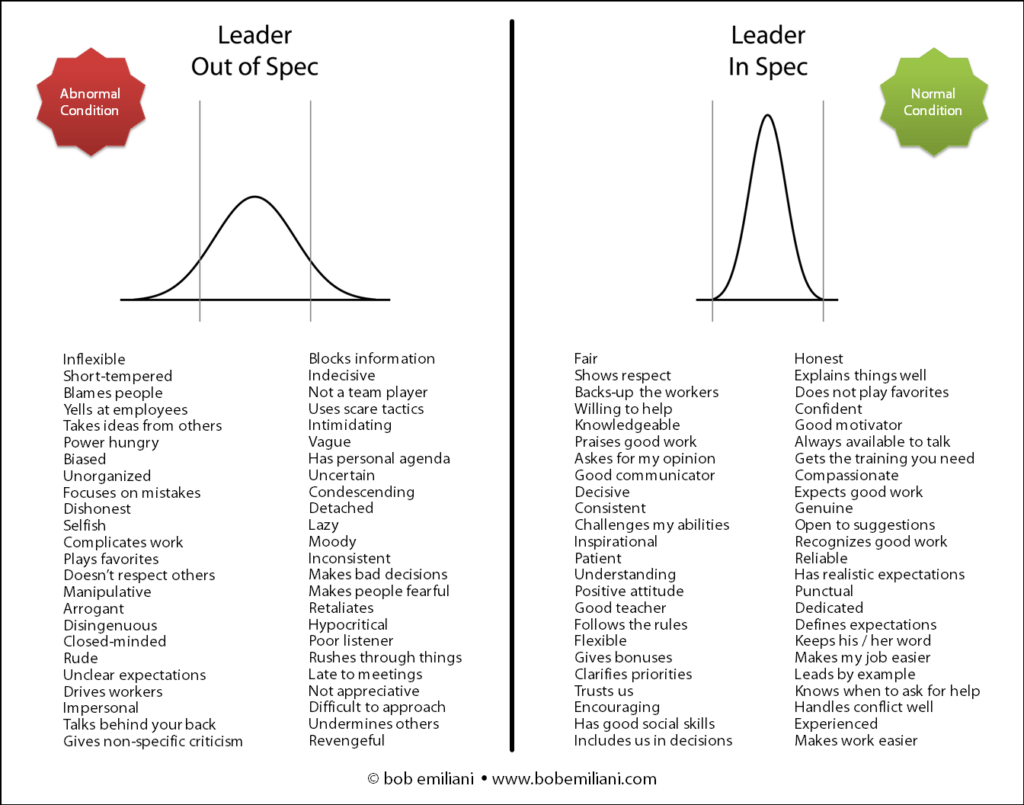Did you not know there were specifications for leaders? How could that be? You have probably been a participant in many leadership training courses and have had a lot of coaching, but you are likely not in spec and probably don’t even know it. Leaders, especially top leaders, have earned the status, rights, and privileges to do whatever they want to do. And that they do. So they are nearly always out of spec and thus cause a lot of problems, big and small, whose source is… themselves.
Most of my former undergraduate students worked in manufacturing businesses, even though many were engaged in services that supported operations. Most, if not all, understood the concept of specifications and whether the product or service they produced in their job was in spec or out of spec. I decided to apply this concept to how I taught leadership to students as part of a broader education on what constituted good and bad leadership.
The simplicity of the in spec and out of spec concept resonated with students. It was much easier for them to understand and recognize good leadership from bad. This was useful to them in their current job, as well as if they sought a different job within the company or external to it. It guided them towards working in the parts of the company that were led by in spec bosses and avoid those parts that were led by out of spec bosses. This, of course, would result in a much better work experience for them.

The image above is a version of a handout that I gave to my undergraduate students. It was created by asking students what they, as customers of leadership services, thought was good and bad leadership based on their personal experiences at work. The full version contained 65 specific items for both in spec and out of spec leadership.
Out of spec leadership is an abnormal but common condition. In spec leadership is the normal but uncommon condition. No leader is 100 percent out of spec or 100 percent in spec. Leaders are humans and they make mistakes. Some leaders are highly inconsistent and vacillate between in spec and out of spec on an hourly or daily basis. We all know leaders who are out of spec most of the time. And we all know leaders who are in spec most of the time. Which type of leader would you want to report to? Which type of leader would you want to be?
Out of spec leaders create and multiply problems and make significant contributions to producing unpleasant, constantly chaotic environments that lead to high employee turnover and poor quality work. In spec leaders eliminate problems and help produce a stable environment where people can do good work and develop and grow. The odd thing is that while any sane person would rather report to an in spec leader, most people when they become leaders are out of spec — even if they have received a lot of leadership training and coaching.
The consequence of that is employees park their brains at the front door. Meaning, they come to work every day to do their job, but rely on the boss to tell them what to do and when to do it, and not think about how they can improve their job. The out of spec boss shuts down ideation, creativity, and innovation, things that any business needs, but especially those that exist in competitive business markets. The in spec boss does not do that. They do not cause the widespread harm that out of spec bosses cause.
As I have noted many times before, out of spec leaders function at an amateur level of leadership practice, and they typically remain stuck at that level because that is the level at which most of their bosses and peers function. Consequently, they see no need to change, not realizing the large negative impact they have on their team. Leaders that are in spec function at a much higher, professional level. The danger for them is that they can slip back to their peers’ amateur level at any time, usually the result of increasing pressure from bosses above them. They must resist pressure to conform to the amateur level of leadership that surrounds them.
So what is it that perpetuates the existence of out of spec leaders? Two things: The first is that being out of spec confers prized advantages to leaders in terms of status, rights, privileges, power, and control over people, processes, and budgets. This allows leaders, especially top leaders, to assure that benefits continue to accrue them at the expense of regular employees (and society). Few leaders have any desire to give that up. There is no reason, from their point of view, to break with tradition.
The second answer is less obvious but intimately connected to the first. Leaders are out of spec because of the network of archaic economic, social, political, historical, philosophical, business, aesthetic, spiritual, and legal preconceptions that inform top leaders’ thinking, from one generation to the next, which in turn influences all levels of leaders below them. The abnormal condition of out of spec leadership will continue for as long as the network of leaders’ preconceptions remain unchanged. The emergence of artificial intelligence will likely do little to change that for the foreseeable future because AI is strengthening the already strong hand of top leaders.
What’s next is most likely to be determined by what is.
– Douglas F. Dowd (1919-2017)
